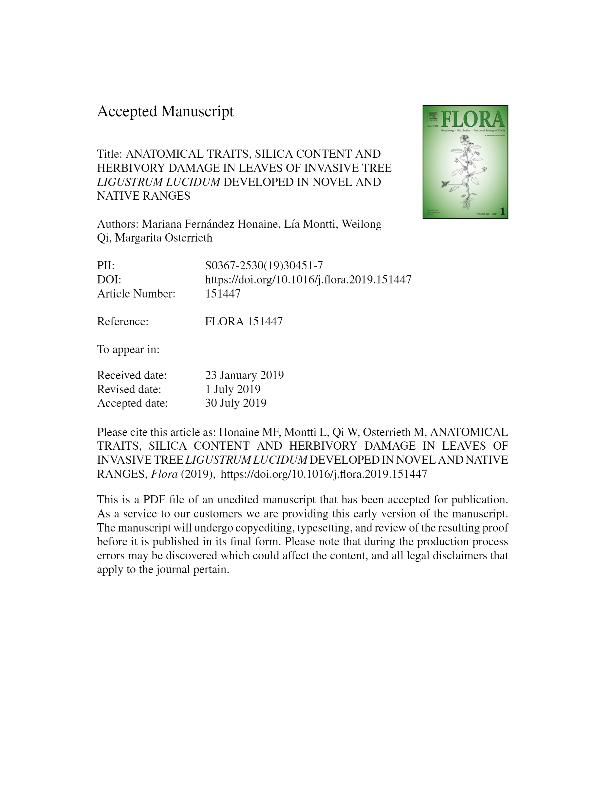Artículo
Anatomical traits, silica content and herbivory damage in leaves of invasive tree Ligustrum lucidum developed in novel and native ranges
Fecha de publicación:
09/2019
Editorial:
Elsevier Gmbh
Revista:
Flora
ISSN:
0367-2530
Idioma:
Inglés
Tipo de recurso:
Artículo publicado
Clasificación temática:
Resumen
Ligustrum lucidum is an invasive tree in many regions, but scarce work analyzes its anatomical or eco-functional traits and its relation with herbivores, an important issue to be addressed by invaders in new areas. On the other hand, amorphous silica accumulation is an important anti-herbivore component in grasses, but its role in eudicots has been little explored. To analyze if anatomical and eco-functional traits, silica accumulation and herbivory damage are modified by phenological stages or environmental conditions, and if herbivory damage is negatively correlated with silica content, we analyzed shade and sun leaves of different ages from adult trees in novel (Argentina) and native (China) areas. Leaves were scanned, dried and weighed for specific leaf area estimation. Herbivore damage was calculated as the proportion of leaf surface eaten. Silica content was quantified through calcination and digestion techniques. The results showed that leaves from China had higher SLA than leaves from Argentina, and shade or young leaves had higher SLA than sun or old leaves. Herbivory was higher in old leaves compared to young ones. Mean silica concentration was 1.73%; it was higher in leaves from Argentina than in leaves from China and it increased with leaf age. Differences in silica concentration or SLA between samples are probably due to environmental conditions such as pollution degree, soil Si content, water availability and / or temperatures. The age of the leaves affected the values of SLA, silica content and herbivory damage. Along the life of the leaves, silica content increased approximately five times in ten months: older leaves became thicker, with a higher silica content, and a higher herbivory damage. Considering the same age of the leaf, silica concentration and herbivory damage were not correlated, therefore it was not possible to associate the silicification process with an antiherbivore role in this species.
Palabras clave:
LEAF ANATOMY
,
LEAF ONTOGENY
,
SILICIFICATION
,
CHINA
,
ARGENTINA
,
INVASION
Archivos asociados
Licencia
Identificadores
Colecciones
Articulos(IIMYC)
Articulos de INSTITUTO DE INVESTIGACIONES MARINAS Y COSTERAS
Articulos de INSTITUTO DE INVESTIGACIONES MARINAS Y COSTERAS
Citación
Fernández Honaine, Mariana; Montti, Lia Fernanda; Weilong, Qi; Osterrieth, Margarita Luisa; Anatomical traits, silica content and herbivory damage in leaves of invasive tree Ligustrum lucidum developed in novel and native ranges; Elsevier Gmbh; Flora; 258; 9-2019
Compartir
Altmétricas




